What is a startup and how do you launch one?
Aug 25th, 2022

When somebody mentions the word “startup”, we immediately think of Facebook, Apple, Amazon, Netflix, and Google. All these tech giants used to be young companies that turned into the dominant players in their industries. Each mentioned corporation started from an idea and came a long way in overcoming various obstacles, such as lack of funding and the risk of failure. Now the other newcomers in business study their success stories and implement their business models and best practices.
A startup is more than a small business. It is a company with a soul. It motivates people to contribute their time, money, and energy and evokes a feeling of deep connection and shared purpose. Startup founders perceive their companies as something more than just a business. Perhaps, this is the main reason why startups become market leaders, encourage innovation, and foster positive changes in the world. Startups develop new business models that are later replicated by their successors. So let us dive into the specifics of building a startup and how to drive its growth.
What is a startup?
A startup is a newly established company or venture that creates unique products or services aimed at innovation. The other definition of a startup is as follows: a series of experiments to identify the solution to the problem and find, develop and test a fitting business model. Startups are businesses in the early stage of development as they establish their identity and mission or launch a product. While creating a startup, business owners focus on financing, market research, corporate structure, and fulfilling legal obligations for operating the business.
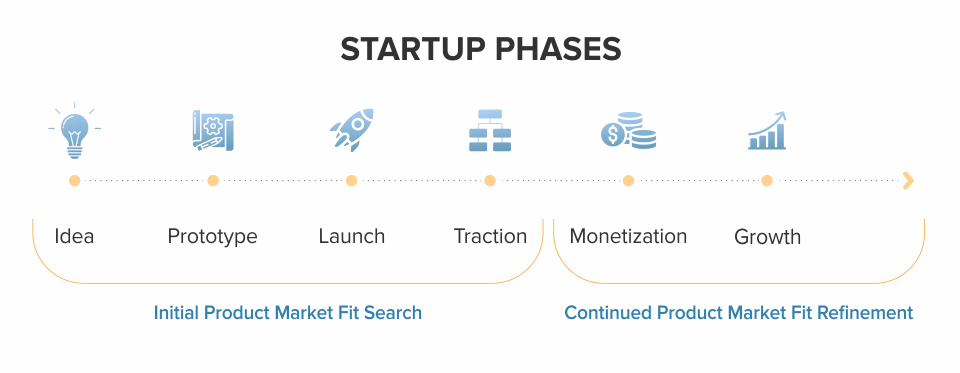
Launching a startup aims to develop an entirely new group of products or create exceptional and competitive solutions that seek to correct the shortcomings of existing offers. In many cases, the startups disrupt traditional business practices in whole industries. However, startups often experience a lack of financial resources at the beginning, so they raise funding from different sources, such as loans or crowdfunding. Moreover, due to insufficient funding, these companies are often financed by their founders, family, and friends.
Startups focus on bringing a single product to the market and frequently have an imperfect business model. The newly formed companies have a small number of employees and excellent growth potential. In the initial stages of existence, startups face a high probability of failure. According to statistics, only 10% of early-stage startup companies survive and achieve success. In addition, more than 50% of young companies fail in the first five years, and more than 70% fail within ten years of operation. Thus, we can sum up that a startup is a recently created fast-growing business that solves a problem, disrupts the market, and operates in a highly uncertain environment.
Startup vs a small business
Startups and small businesses are not the same. Although both types of companies typically have few team members, experience a lack of funding and compete against industry leaders, there are several striking differences between the organizations.
The critical difference lies in innovation. Small company duplicates the existing template of business operation. Using small business marketing strategies, such companies strive to serve a particular market or market segment in the already tested way to generate a profit. In contrast, a startup strives to find non-standard solutions to problems and significantly impact the current market. Besides, startups try to identify and adopt a repeatable and sustainable business model. Thus, startups face a higher degree of risk in attempting to create a revolutionary product or service and, in some cases, develop a new niche.
The other difference is funding. Both startups and small businesses can be financed by founders, but the latter may use loans and grants as financing sources. On the other hand, startups may receive funding from angel investors or initial public offerings.
Small businesses provide products for a local market and put most of their efforts into long-term stability, so they do not focus on rapid growth. At the same time, startups strive to grow fast and scale globally. While the main goals of small businesses include running a profitable company and achieving success on a regional or national level, startups aspire to become industry leaders and occupy a niche in the international market.
Why launch a startup?
A startup is looking to find and validate a business model before the founders can implement it. The objective is to find the ideal balance of pricing, positioning, segmentation, differentiation, and distribution. During the search period, business owners can change the idea, the solution, or the target customers. Once the model is found, a startup seeks to scale services as much as possible. Therefore, the goal of a startup is not to generate a profit. However, when the startup completes the scaling stage, it becomes a reliable, profit-generating business.
The most common reasons to launch a startup include fulfilling the unsatisfied market demand and making a positive impact on the world. Whether it is a social startup designed for low-income communities or an eco-friendly startup that aims to reduce environmental pollution, the primary objective of creating a startup is to improve people’s lives. It is the desire to change the world and create added value through productivity improvement that is the primary motivating factor for startup founders.
How to launch a startup?
We have already discussed the motivation to launch a startup, so now it is time to consider the process of building a startup from scratch. We will review the most crucial components and stages of startup development.
Lean approach
The lean approach is a methodology for launching a startup that implies constant testing, iterating, and experimenting based on the results of research and customer feedback. The methodology aims to reduce product development cycles and accelerate the evaluation of the viability of a suggested business model. The lean startup approach was first mentioned in the book "How Today's Entrepreneurs Use Continuous Innovation to Create Radically Successful Business", published by Eric Ries in 2008.
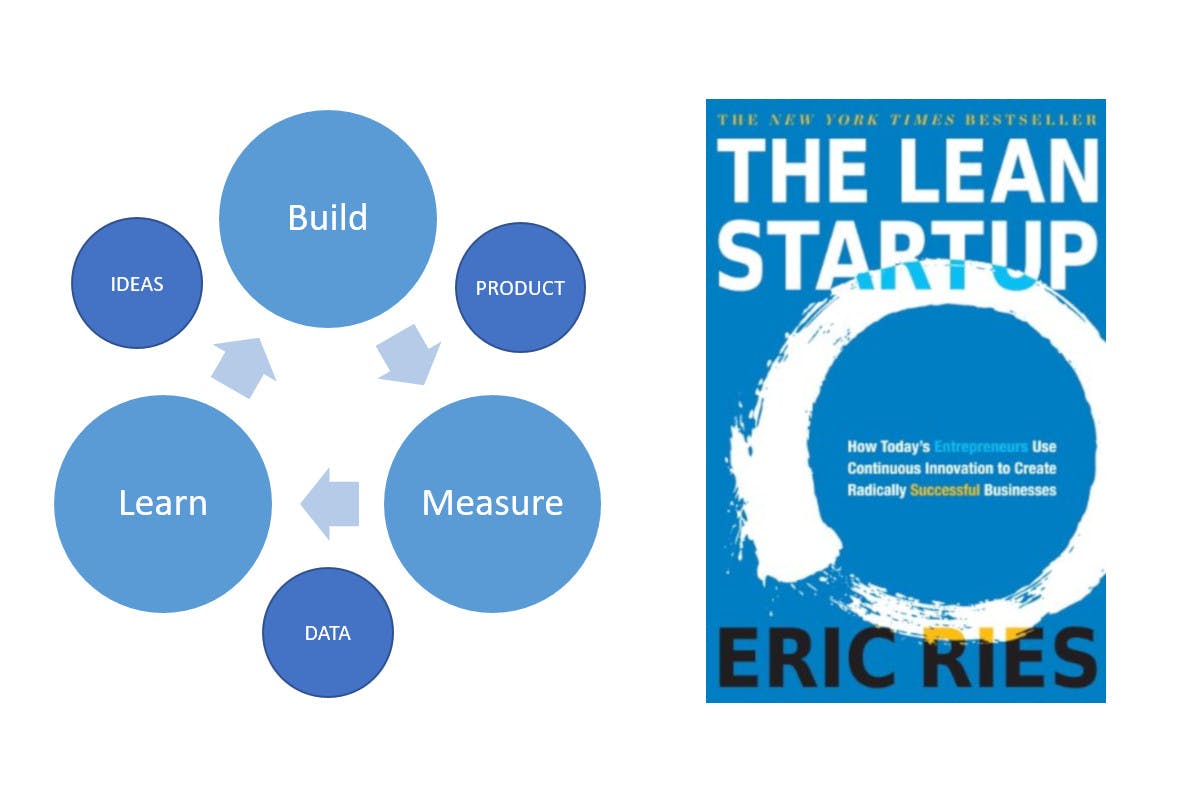
Many startups spend too much time developing a product they believe will meet customer demands. However, they often experience failure. The reason is poor communication with potential customers. Lean startup methodology allows us to get around this problem, determine the buyers’ interest by using validated learning and create a product based on consumer needs.
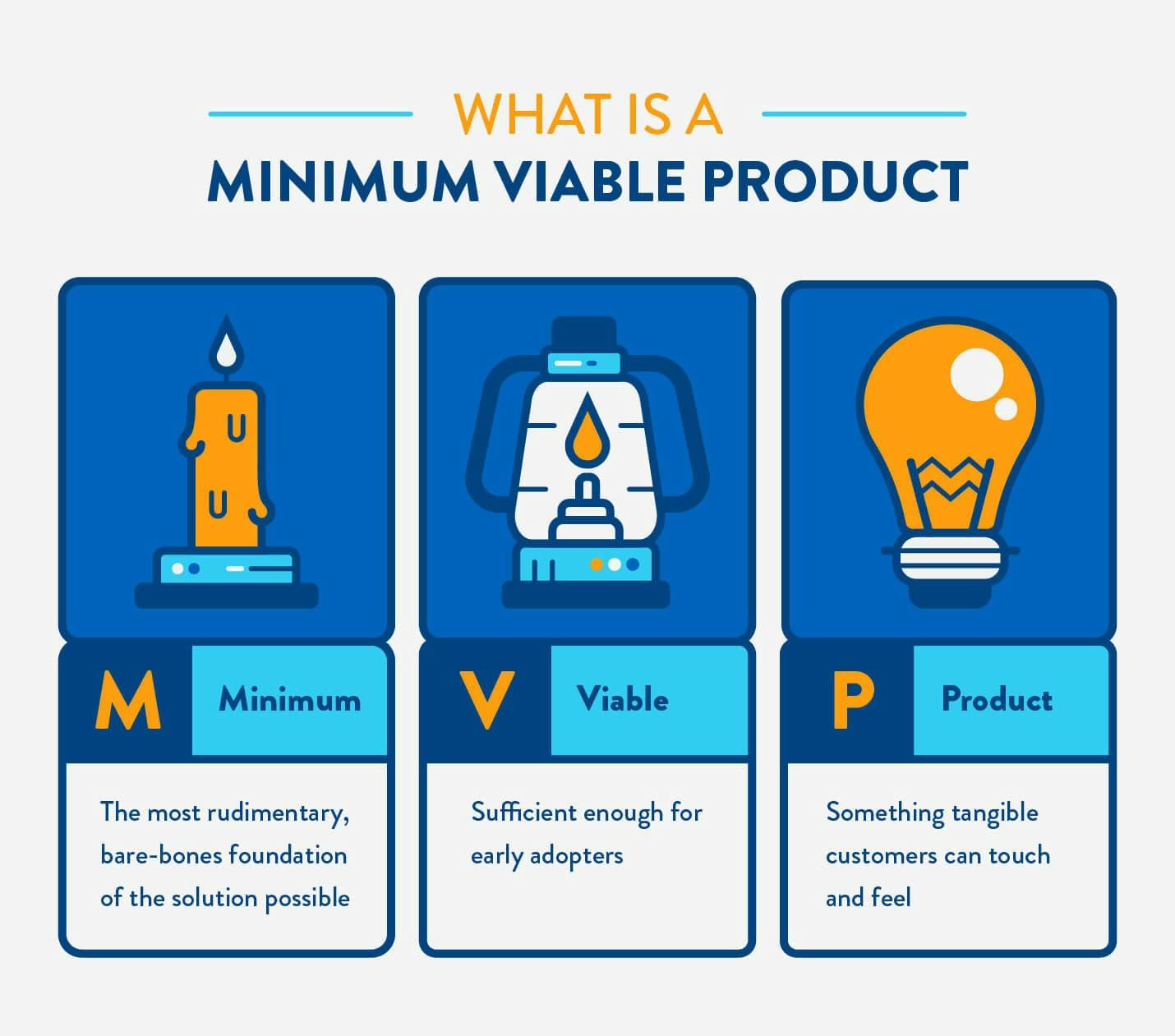
The methodology consists of three key steps: product-market fit, problem-solution fit, and growth. The main principle that underlies the lean startup approach is build-measure-learn.
First, the company develops a minimum viable product that has enough basic features to conduct testing with users. The next step is to collect customer insights and analyze the feedback. Finally, the company decides whether the product features should be improved or eliminated. Then the startup adds new features and repeats the process. As a result, once the product is finished, the company already has a customer base, understands consumer requirements, and is ready to grow.
Team
One of the main reasons why startups fail is a weak team. A diverse team with various skills is a crucial factor for startup success. Moreover, this aspect is critical for stakeholders when determining whether or not to invest in a company. Naturally, the team structure dramatically depends on the idea of the product you plan to bring to the market. Nevertheless, some key players of a startup team are the same for every industry and product.
The central figure in a startup team is the CEO, who is not necessarily the business founder. While the founder is the author of the idea, the CEO is responsible for making essential corporate decisions and managing resources and the company’s daily operations. The other CEO's responsibilities include communicating with employees and the board of directors and ensuring they stick to a company’s culture and vision.
The other vital player is the CTO or chief technology officer, whose duties entail managing the technical processes, such as R&D operations. The team is incomplete without a chief marketing officer and communication manager responsible for the company’s marketing initiatives. The product manager will take care of product development and strategy. The sales manager and customer support manager will be responsible for communication with potential clients. Finally, the financial manager will help you handle all the company’s financial operations.
Planning
When the team is set up, the next phase is to plan the steps for the first stages of the startup. The perfect solution is to prepare a business plan that comprises the following elements: an executive summary, company summary, market analysis, product or service description, management and operational structure, and marketing and financial plans.
The executive summary outlines your business model and describes the target market, go-to-market strategy, competitors, objectives, and business opportunity. The company description allows investors to understand your mission and the value you offer, so it should provide a brief overview of your company’s operations, vision and mission statement and explain the business concept.
Then you need to perform market research to identify customer segments and provide an analysis of your competition. After that, you can describe how your product or service will meet market demand. The following step is to outline the team structure and highlight the experience and strengths of the employees. Next, you should consider marketing activities and sales channels you will use to promote products or services and engage with potential customers. The final step is the detailed financial plan that addresses significant expenses, salary demands, financial milestones, and sources of income.
Now it is time for brainstorming and generating product concepts. Meet with your team and come up with a number of ideas that satisfy customer needs. The following stage is prototyping. First, you must create the simplest form of your product and gather feedback. Next, conduct marketability tests in small groups to understand how potential customers view your product. Use the responses to modify the prototype according to the clients’ requirements. Repeat the stages while adding new features to the prototype.
Product-market fit and first customers
The following step is to test the business model and attract the first clients. Product-market fit is when the product meets customer needs in relevant market segments and distribution channels. Achieving product-market fit is critical for a startup in the first phase of development as otherwise, there is a risk of wasting time and money and losing potential customers.
The first step to reaching product-market fit is to determine your target customer. You need to analyze your product or service, study your competitors and use market segments to identify your ideal client and create a buyer persona. Then you should understand consumers’ pain points by analyzing feedback, conducting customer interviews, and seeking insights from your marketing and sales teams. Finally, focus on client needs that your product or service can most effectively meet and create a value proposition.
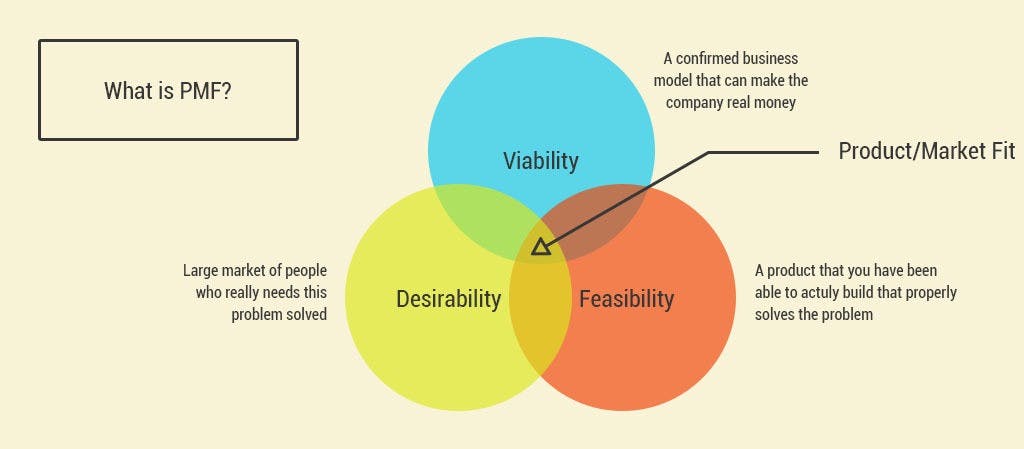
The next step is to measure a product-market fit. Calculate your total addressable market or the number of clients who can take advantage of your product or service. The formula for calculating TAM is as follows: a total number of customers × average revenue per user. After that, you can evaluate product validation by conducting surveys and interviews. Remember that customer demands change over time, so you should frequently analyze market conditions to continue satisfying the requirements.
Partners
Finding the right partners can provide you with the necessary connections and resources and contribute to the startup's growth. A great partner can compensate for the skills gap or point out the blind spots in your management style. In addition, the partners can supply the raw materials if they are crucial for your operations or provide data that you might work with and resell to end clients.
To choose the right partner for your startup, list short-term and long-term business objectives. Analyze your needs to understand what assets you already have and what resources you might require. Next, create the idea pitch to describe how the potential partner will benefit from collaboration with you. Finally, tailor your pitch to the needs of a partner you are going to talk to.
Consider the social connections you already have, such as university friends or colleagues. Visit thematic conferences and startup events and check online networks for entrepreneurs, such as CoFoundersLab. Organize the information about your business partners by using data sheets and contact forms to collect prospective partners’ skills, goals, and contact details.
Development
Once we have clarified the major aspects, it is crucial to start planning the development. You need to keep in mind that you might not succeed on the first try. Due to this reason, you should plan the chance of potential failure on the first or second try. You can increase the chances for success by leaving some resources to change what you’ve developed the first time.
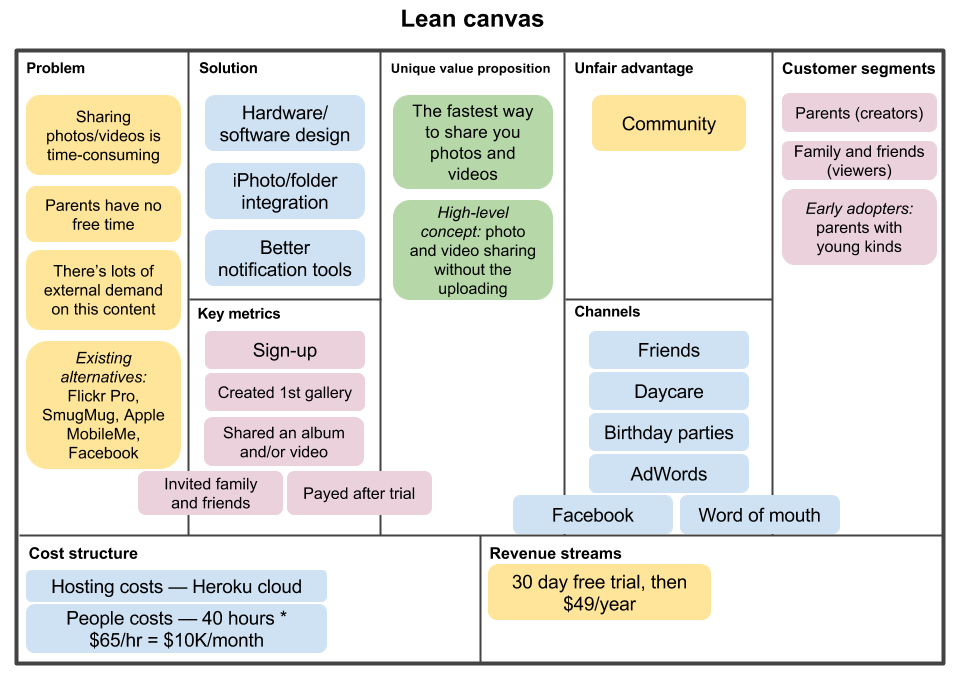
When planning the startup development, consider the method introduced by Ash Maurya, who created the technique based on the lean methodology by Eric Ries. In his book “Running Lean”, Ash Maurya compared the approach with a standard business model and developed the canvas for the startup. He included only the most vital components that affect the probability of failure and carry the most risk.
The most crucial elements in development planning are a problem, solution, key metrics, and unfair advantage. The problem refers to users’ pain points solved by your product or service. The solution implies the development of a minimum viable product we described earlier. Key metrics are indicators that reflect the performance of your startup. The unfair advantage is the unique feature that allows your company to leave its competitors behind.
So, let us consider the process of product development in practice. First, create the minimum viable product to evaluate the feasibility of your idea. Then, if you receive positive customer feedback, you can proceed to the next step and test market adoption. Now you can analyze whether the product is accepted by your target market and determine the most-used features you need to pay attention to at the final stage of development.
Once you have examined customer reaction to your minimum viable product, you can start the full-fledged development stage. If all goes well, you can proceed to the launch and introduce the product to the market. At this stage, your product development team should continue monitoring the feedback and adding new features or improving the existing ones if necessary. After the successful product release, your following tasks are branding, promotion, and determining the right price for the product.
Feedback and continuous improvement
Collecting feedback is extremely important for a startup’s success. It allows you to understand the level of customer satisfaction, what features should be improved and which pricing model you need to choose. Moreover, feedback helps you create a better consumer experience and demonstrate that customer opinion is valuable to you.
First, you can ask for feedback from your friends, family, and colleagues. Pay close attention to people who share characteristics of your buyer persona. Introduce usability tests, questionnaires, customer interviews, short in-app surveys, and live chats to collect responses. Ask people what they like about your offer, what goals they are trying to achieve using the product, and what challenges they encounter. Organize the feedback in one place and make constant changes to the product. No matter what kind of feedback you get — positive or negative — everything you learn will help you improve your company.
In the next section of the article, we will consider one more essential component for the development of the startup, which is funding.
Startup funding
Launching a startup often requires significant investment. Therefore, the issue of funding is one of the main challenges for young companies. Even though some startup founders use their own capital to launch a startup, other business owners can face difficulties finding money for their endeavors. Therefore, we will review various funding sources available for founders.
Bootstrapping
Bootstrapping is when an entrepreneur launches a startup without outside financing. A business owner relies on personal finances, and once the company is established, the founder invests the operating revenue back into the business. This method of funding provides more control over financial decisions, but it also creates more risks. For example, a company may accept preorders for the product and then use the money raised from sales to develop and deliver the product.
Family and friends
First-time founders often use this source of funding when they lack money and industry connections. It is a suitable method of startup financing at the very beginning when you do not yet have a detailed business plan. First, however, you need to outline your strategy and explain the risks. The following steps will help you gently ask your friends and relatives for financial assistance. Present your pitch deck, set clear deadlines for repayment, provide product or service information, describe your backup plan and prepare the agreement.
Crowdfunding
Crowdfunding is the method of funding a company by raising capital from people via the Internet. The most popular crowdfunding platforms are Indiegogo, Kickstarter, and GoFundMe.
There are different schemes of crowdfunding that include reward, donation, equity, and debt. Donation-based crowdfunding is when people invest money in a startup without expecting anything in return. Rewards imply providing compensation for donations. It can be a discounted product or service or branded merchandise. According to an equity-based crowdfunding scheme, participants receive shares in the company depending on the sum of money they invested. Debt-based donations are loans that must be paid back with interest by a specific date.
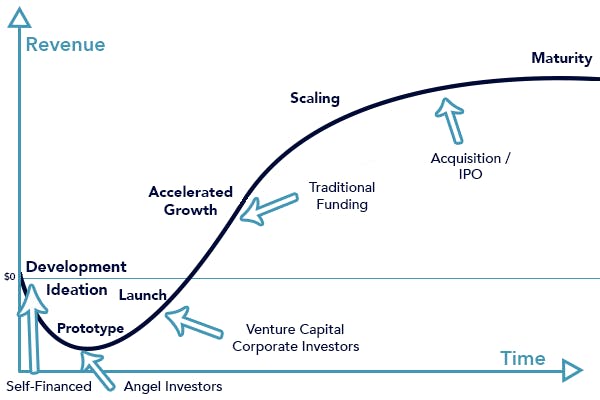
Angel investors
Angel investors are people who contribute money to the startup in exchange for equity or convertible debt. Angel investors typically fund young companies at their very early stages, when the majority of investors are unwilling to support them. Often, a startup founder’s family and friends act as angel investors for his company. Angel investors can provide one-time capital to help business owners launch a startup or recurring funding to allow businesses to get through challenging early phases.
Venture capital firms
Venture capital firms finance early-stage companies in exchange for equity shares or ownership interest. Venture capitalists provide investments for risky startups as they expect that young companies will achieve success. Usually, they actively participate in the company’s activities and join the board of directors. Unfortunately, the failure rate of startups funded by venture capital firms is relatively high. To apply for this kind of funding, your firm must demonstrate both innovation and a strong potential for development.
Startup accelerators and incubators
Startup accelerators and incubators are initiatives that offer initial funding, mentoring, and training for business founders. Entrepreneurs who use startup incubators typically have access to a shared space and all the resources available through their program on a month-to-month basis. While incubators concentrate on early-stage businesses that are still developing their products and do not yet have a complete business plan, accelerators concentrate on stimulating the development of businesses with a minimum viable product and proven product-market fit.
Launching a startup is not an easy task. It involves many risks and challenges. However, despite all difficulties, the goal is worth it. If your objective is to change the world with your product and earn some excellent rewards for yourself along the way, then build, measure, learn and try again.
